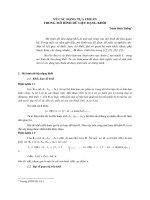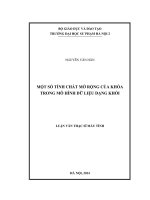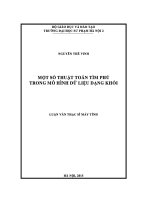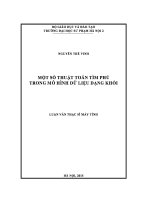Một số quan sát về sơ đồ quan hệ trong mô hình dữ liệu quan hệ. docx
Bạn đang xem bản rút gọn của tài liệu. Xem và tải ngay bản đầy đủ của tài liệu tại đây (2.68 MB, 5 trang )
TiJ.p chi Tin hQc
va
f)i'eu khi€n hQC,
T. 17,
S.2 (2001), 51-55
SOME OBSERVATIONS ON THE RELATION SCHEMES
IN THE RELATIONAL DATAMODEL
vu Due
THI
Abstract.
In this paper, we introduce the new concept of maximal family of a relation scheme. The time
complexity of finding this family is presented in this paper.
Torn tiit.
Trong bai nay, chung t6i trinh bay ho cu'c dai ciia mqt so·
do
quan h~.
1. DEFINITIONS AND PRELIMINARY RESULTS
The relational datamodel which was introduced by E. F. Codd is one of the most powerful
database models. This paper gives some results about computational problems related to relation
schemes. Let us give some necessary definitions and results that are used in next section. The
concepts given in this section can be found in
[1,2,4,6,7,8].
Let
R
=
{aI, , an}
be a nonempty finite set of atributes. A functional dependency (FD) is a
statement of the form
A
-+
B,
where
A, B ~ R.
The FD
A
-+
B
holds in a relation r
=
{hI, , h
m
}
over
R
if
V
hi, h
J
E
r we have
h;(a)
=
hJ(a)
for all
a
E
A
implies
hi(b)
=
hJ(b)
for all
b
E
B.
We also
say that r satisfies the FD A
-+
B.
Let
FT
be a family of all FDs that hold in r. Then
F
=
FT
satisfies
(1) A
-+
A
E
F,
(2) (A
-+
B E F, B
-+
C
E F)
=>
(A
-+
C
E F),
(3) (A
-+
B
E
F, A ~
C,
D ~ B)
=>
(C
-+
D
E
F),
(4)
(A
-+
B E F,
C
-+
D E F)
=>
(A
u
C
-+
BuD E F).
A family of FDs satisfying
(1) - (4)
is called an I-family (sometimes it is called the full family]
over R.
Clearly,
FT
is an I-family over
R.
It is known
[I]
that if
F
is an arbitrary I-family, then there
is a relation rover
R
such that
FT = F.
Given a family
F
of FDs, there exists a unique minimal I-family
F+
that contains
F.
It can be
seen that
F+
contains all FDs which can be derived from
F
by the rules
(1) - (4).
A relation scheme
s
is a pair
(R, F),
where
R
is a set of attributes, and
F
is a set of FDs over
R.
Denote
A+ =
{a:
A
-+
{a}
E
F+}. A+
is called the closure of
A
over
s.
It is clear that
A
-+
B
E
F+
iff
B
<
A+.
Clealy, if
s
= (R, F)
is a relation scheme, then there is a relation rover
R
such that
FT
=
F+
(see
[1]).
Such a relation is called an Armstrong relation of
s.
Let
R
be a nonempty finite set of attributes and
P(R)
its power set. The mapping
H : P(R)
-+
P(R)
is called a closure operation over
R
if for
A, BE P(R),
the following conditions are satisfied:
(1) A ~
H(A),
(2) A ~ B
implies
H(A) ~ H(B),
(3) H(H(A))
=
H(A).
Let
s
= (R, F)
be a relation scheme. Set
H.,(A) =
{a:
A
-+
{a}
E
F+},
we can see that
H.,
is a
closure operation over
R.
Let r be a relation,
s
=
(R, F)
be a relation scheme. Then
A
is a key of r (a key of
s)
if
A
-+
R
E
FT (A
-+
R
E
F+). A
is a minimal key of
r(s)
if
A
is a key of
r(s)
and any proper subset
52
vu Due THI
of
A
is not a key of
r(s).
Denote
K;
(K.)
the set of all minimal keys of
r (s).
Clearly,
K" K.,
are Sperner systems over
R,
i.e.
A, B
E
K,
implies
A
If:
B.
Let
K
be a Sperner system over
R.
We define the set of antikeys of
K,
denoted by
K-
1
,
as
follows:
K-
1
=
{A
c
R: (B
E
K)
=>
(B
If:
A)
and
(A
c
C)
=>
(::lB
E
K)(B ~
C)}.
It is easy to see that
K-
1
is also a Sperner system over
R.
It is known
[5]
that if
K
is an arbitrary Sperner system over
R,
then there is a relation scheme
s
such that
K.,
=
K.
In this paper we always assume that if a Sperner system plays the role of the set of minimal keys
(antikeys), then this Sperner system is not empty (doesn't contain
R).
We consider the comparison
of two attributes as an elementary step of algorithms. Thus, if we assume that subsets of
Rare
represented as sorted lists of attributes, then a Boolean operation on two subsets of
R
requires at
most
[R!
elementary steps.
Let
L ~ P(R). L
is called a meet-irreducible family over
R
(sometimes it is called a family of
members which are not intersections of two other members) if
V
A, B,
C E
L,
then
A
=
B
n
C
implies
A
=
A
or
A
=
C.
Ilet
I ~ P(R), REI,
and
A,
BEl
=>
An
BEl. I
is called a meet-semilattice over
R.
Let
M ~ P(R).
Denote
M+
=
{nM' :
M' ~ M}.
We say that
M
is a generator of
I
if
M+
=
I.
Note
that
R
E
M+
but not in
M,
by convention it is the intersection of the empty collection of sets.
Denote
N
=
{A
E
I: A
=f
n{A'
E
I : A
c
A'}}.
In [5] it is proved that
N
is the unique minimal generator of
I.
It can be seen that
N
is a family of members which are not intersections of two other members.
Let
H
be a closure operation over
R.
Denote
Z(H)
=
{A : H(A)
=
A}
and
N(H)
=
{A
E
Z(H) : A
=f
n{A'
E
Z(H) : A
c
A'}}. Z(H)
is called the family of closed set
s
of
H.
We say that
N (H)
is the minimal generator of
H.
It is shown [5] that if
L
is a meet-irreducible family then
L
is the minimal generator of some
closure operation over
R.
It is known [1] that there is an one-to-one correspondence between these
families and f-families.
Let
r
be a relation over R. Denote E;
= {EiJ :
1 ::;
i
<
j ::;
Irl},
where
EiJ =
{a
E
R :
hda)
=
hJ(a)}.
Then
E;
is called the equality set of
r.
Let
T;
=
{A
E
P(R) : ::lEiJ
=
A,
pEp,! :
A
eEl''!}'
We say that
T;
is the maximal equality
system of
r.
Let
r
be a relation and
K
a Sperner system over
R.
We say that
r
represents
K
if
K;
=
K.
The following theorem is known [7,10].
Theorem
1.1.
Let K be a non-e";"pty' Sperner system and r a relation over R. Then r represents K
iff
K-
l
=
T"
where
T;
is the maximal equality system of r.
Let
s = (R, F)
be a relation scheme over
R, K.
is a set of all minimal keys of
s.
Denote by
tc;'
the set of all antikeys of
s.
From Theorem
l.1
we obtain the following corollary.
Corollary
1.2.
Let s = (R, F) be a relation scheme and r a relation over R. We say that r represents
s if
K;
=
K •. Then r represents s iff
K;l
=
T"
where
T;
is the maximal equality system of r.
In [6] we proved the following theorem.
Theorem
1.3.
Let r = {hl, , h
m
}
be a relation, and Fan f-family over R. Then F;
every A ~ R
F iff for
SOME OBSERVATIONS ON THE RELATION SCHEMES IN THE RELATIONAL DATAMODEL 53
{
n
E
tJ
HdA) =
~C:;;EiJ
otherwise,
where HdA) = {a
E
R : A
->
{a}
E
F} and E;
is
the equality set of r.
'I'heor
ern
1.4.
[3]
Let K
=
{K1, ,K
rn
} be a Sperner system over R. Set
s
{K
1
->
R, ,Km
->
R}. Then K., = K.
(R, F)
with
F
2. MAXIMAL FAMILY OF A RELATION SCHEME
In this section we introduce the new concept of maximal family of a relation scheme. We show
that the time complexity of finding a maximal family of a given relation scheme is exponetial in the
number of attributes.
Now we prove that the time complexity of finding a set of antikeys for relation scheme is expo-
nential in the number of attributes. We show that finding a maximal family of a relation scheme can
be polynomially transformed to this problem.
Definition 2.1.
Let s
=
(R, F)
be a relation scheme. Set
H.(A) = A+
for all.A
<:;;
R.
Put
Z(s)
=
{A : A
=
A+}.
Denote by
N,
the minimal generator of
Z(s).
Set
M(s)
=
{(A,{a}) : a
if.
A, A
E
Z(s)
and
BE Z(s)' a
if.
B, A
<:;;
B
imply
A
=
B}.
Then we say
that
M(s)
is a maximal family of s.
Put
I'll
=
{A,
{a})
E
M(S)
and
L(1',,)
=
{A : (A,
{a})
E
T,t}.
Let s
=
(R, F)
be a relation scheme over
R.
From
s
we construct
Z(
s)
and compute the minimal
generator
N,
of
Z(s).
We put
T, = {A
E
N, :JJB
E
N, : A
c
B}.
It is known [1] that for a given relation scheme
s
there is a relation
r
such that
r
is an Armstrong
relation of s. On the other hand, by Corollary 1.2 and Theorem 1.3 the following proposition is clear.
Proposition
2.2.
Let
s
=
(R, F)
be a relation scheme over
R.
Then
tc;: =
1'.,.
It is shown [7] that the problem of finding all antikeys of a relation is solved by polynomial time
algorithm. For a relation scheme we have the following theorem.
Theorem
2.3.
The time complexity of finding a set of all antikeys of a given relation scheme
is
exponential in the number of attributes.
Proof.
We have to prove that:
(1) There is an algorithm which finds a set of all antikeys of a given relation scheme in exponential
time in the number of attributes.
(2) There exists a relation scheme
s
=
(R, F)
such that the number of elements of
K;
1
is exponential
in the number of attributes (in our example
IK;ll
is exponential not only in the number of
attributes, but also in the number of elements of
F).
For (1), we construct a following algorithm:
Let s
=
(R, F)
be a relation scheme over
R.
Step 1: For every
A
<:;;
R
compute
A+,
and set
Z(s) = {A+ : A
<:;;
R}.
Step 2: Construct the minimal generator
N,
of
Z(s).
Step 3: Compute the set
1',
from
N,.
According the to Proposition 2.2 we have
1',
=
K.,.
Clearly, the time complexity of this algorithm is exponential in
IRI·
54
vu Due THI
As to
(2):
Let us take a partition
R
= Xl U ·uXmuW,
where m
=
[n/3]'
[RI
=
nand
IXI = 3
(1 ~
i ~
m).
Set
K
=
{B : IBI
= 2,
B ~
Xi
for some
i}
if
IWI
= 0,
K
=
{B : IBI
=
2,
B ~
Xi
for some
i :
1 ~
i ~
m -
1 or
B ~
x.;
U
W}
if
IWI
=
1,
K
=
{B : IBI
=
2,
B ~
Xi
for some
i :
1 ~
i ~
m
or
B
=
W}
if
IWI
=
2.
It is easy to see that
tc:'
=
{A:
IAnxil = 1, Vi}
if
IWI
=
0,
K -
1
=
{A :
I
A
n
Xi
I=
1( 1 ~
i ~
m - 1) and
I
A
n
(X
Tn
U
W)
I=
I} if
I
W
I=
1,
K-
l
='
{A: IA
n Xi 1=
1 (1 ~
i ~
m) and
IA
n
Wj
=
I} if
IWI
=
2.
Let
f :
N
>
N (N
is the set of natural numbers) be the function defined as follows:
{
3n/3
if
n
==
0 (mod 3),
f(n)
=
~.3In/31
if
n
==
1 (mod
3),
2.3
In
/
31
if
n
==
2 (mod 3).
It can be seen that
f(n)
=
IK-li
and 3
1n
/
41
<
f(n).
It is clear that
n -
1 ~
IKI ~
n
+
2, 3
1n
/
41
<
IK-li.
Thus, if denote the elements of
K
by
Kl, ,K
t
,
then we set s
=
(R,F),
where
F
=
{K
l
>
R, , K
t
>
R}.
By Theorem 1.4
K-
l
is the set of all antikeys of s. Consequently,
for an arbitrary set of attributes we can always construct a relation scheme s
=
(R, F)
such that
IFI
<
IRI
+
2, but the number of antikeys of s is exponential not only in the number of attributes,
but also in the number of elements of
F.
The theorem is proved.
According to Proposition
2.2
we show that finding a maximal family
M(s)
can be polynomially
transformed to problem of finding all antikeys of given relation scheme.
Algorithm 2.4.
Input: Let s
=
(R, F)
be relation scheme.
Output:
K.;
1.
Step 1: For each
a
E
R
we construct
Ta.
Step 2: Set
Ns=
U
L(Ta).
<LER
Step 3: Put
«;'
= {A
E
N., :lJB
E
N, :
A
C
B}.
Clearly, the steps 2 and 3 of this algorithm require polynomial time in the number of attributes.
On the other hand, according to Theorem 2.3 we have the following.
Corollary 2.5.
Let
s
= (R, F) be a relation scheme. Then the time complixity of finding the family
M(s) is exponential in the number if attributes.
REFERENCES'
[1] Armstrong W. W., Dependency structures of database relationships,
Information Processing,
Holland Publ. Co.,
74
(1974) 580-583.
[2] Beeri C., Bernstein P. A., Computational problems related to the design of normal form rela-
tional schemas,
ACM Trans. on Database Syst.
4 (1) (1979) 30-59.
[3] Beeri C.,
Dowd
M., Fagin R., Staman R., On the structure of Armstrong relations for functional
dependencies,
J. ACM31
(1) (1984) 30-46.
[4] Bekessy A., Demetrovics
J.,
Contribution to the theory of database relations,
Discrete Math.
27
(1979) 1-10.
SOME OBSERVATIONS ON THE RELATION SCHEMES IN THE RELATIONAL DATAMODEL 55
[5] Demetrovics J., Logical and structural investigation of relational datamodel,
MTA - SZTAKI
Tanulmanyok, Budapest
114
(1980) 1-97 (Hungarian).
[6] Demetrovics J., Thi V. D., Some results about functional dependencies,
Acta Cybernetica
8 (3)
(1988) 273-278.
[7] Demetrovics J., Thi V. D., Relations and minimal keys,
Acta Cybernetica
8 (3) (1988) 279-285.
[8]
Demetrovics J., Thi V. D., On keys in the relational datamodel,
Inform. Process. Cybern. ElK
24
(10) (1988) 515-519.
[9] Demetrovics J., Thi V. D., On algorithm for generating Armstrong relations and inferring func-
tional dependencies in the relational datamodel,
Computers and Mathematics with Applications
26 (4) (1993) 43-55.
[10] Demetrovics J., Thi V. D., Armtrong relation, functional dependencies and strong dependencies,
Comput. and AI
14
(3) (1995) 279-298.
[11] Mannila H., Raiha K. J., Design by example: an application of Armstrong relations,
J.
Comput.
Syst. Scien.
33
(1986) 126-141.
[12] Osborn S. L., Testing for existence of a covering Boyce-Codd normal form,
Injor. Proc . Leit,
8
(1) (1979) 11-14.
[13] Thi V. D. Investigations on combinatorial characterizations related to functional dependencies
in the relational datamodel,
MTA-SZTAKI Tanulmanyok, Budapest
191
(1986) 1-157, Ph.D.
Dissertation (Hungarian).
[14] Thi V. D. Minimal keys and antikeys,
Acta Cybernetica
7 (4) (1986) 361-371.
[15] Thi V. D. On the antikeys in the relational datamodel,
Alkalmazott Matematikai Lapok
12
(1986)
111-124 (Hungarian).
[16] Thi V. D., Logical dependencies and irredundant relations,
Computers and Artificial Intelligence
7
(2) (1988) 165-184.
[17] Thi V. D., Demetrovics J., Some results about normal forms for functional dependency in the
relational datamodel,
J.
Discrete Applied Mathematics, North Holland
69
(1996) 61-74.
[18] Thi V. D., Demetrovics J., Describing Candidate Keys by hypergraphs,
J.
Computers and Ar-
tificial Intelligence
18
(2) (1999) 191-207.
[19] Thi V. D., Demetrovics J., Some computational problems related to Boyce-Codd normal form,
Anales Univer. Sci. Budapest,
Sect. Compo No. 19 (2000) 119-132.
[20] Yu C. T., Johnson D. T., On the complexity of finding the set of candidate keys for a given set
of functional dependencies,
IPL
5 (4) (1976) 100-101.
Received May
16,
2000
Institute of Information Technology









